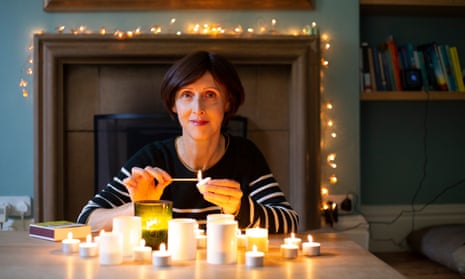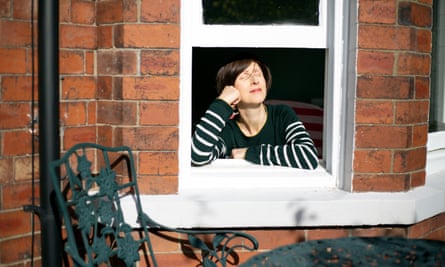Wholesome soup, night walks and wearable sleeping bags: how to prepare for winter – and even embrace it

Many of us dread the nights drawing in and this year there is added apprehension. Here experts offer advice to get yourself through the colder months
Winter is coming and the beauty of autumn – red and gold spreading across the neighbourhood trees; low-hanging mist; a morning glitter of frost – has an ominous quality this year. I don’t need to set out why we are all facing the next few months with real apprehension: almost every headline is doing that for me. The grim bonus is meteorologists predicting that La Niña may mean a colder-than-usual early winter.
But even at the best of times, I don’t think we as a nation deal with winter brilliantly. It’s something to endure or escape rather than appreciate or even enjoy. I personally fixate on Christmas, a frenetic emotional maelstrom – more powerful even than the John Lewis advert – of family, financial anxiety and festive frankenfoods. Then I lurch into some absurdly puritanical “new year, new you” regime for four minutes before giving up and spending months in custard-fuelled, snotty, grey lethargy. But does it have to be this way? I talked to experts to find out how eating, dressing, moving and generally living a bit differently might help me embrace, and even enjoy, winter.
Will more daylight help?
“It can be really tempting in the middle of winter to shut yourself indoors, look out the window and go ‘Ugh, I don’t fancy that,’” says Linda Geddes, the author of Chasing the Sun, an exploration of the science of sunlight. But there are great reasons to go outside, in terms of alertness and mood. “When you’re exposed to bright light, the part of your brain involved with waking you up and making you feel alert is activated,” says Geddes. Light is measured in lux units: depending on the weather, a standard office will be between 80 and 250 lux; outdoors will hit 2,000 to 2,500 on a gloomy day and a bright, sunny winter day can reach 80,000 lux. “So it really is worth trying to get outdoors and get that ‘light snack’.” A 10- to 15-minute walk round the block is enough to get some benefit.

What about Sad lamps, designed to help with the extreme form of winter blues known as seasonal affective disorder? The mechanism by which light affects mood is not yet clear, but it does. Mood, Geddes explains, runs on a 24-hour cycle, lowest around 4am. The main theory of seasonal affective disorder is that low light in winter means our circadian rhythms can’t “reset” as they normally would daily, leaving some people with mood jetlag, waking up still in that low 4am mood. Sad lamps can give your circadian clock an artificial reset, but they only work if used properly: first thing in the morning, and up close. “Sit right next to them,” advises Geddes. “Having it on your table when you’re walking round the kitchen isn’t any good.”
Are there good winter foods?
No magic ingredient will keep you warm in winter. Getting enough calories is crucial and harder-to-digest foods (those with protein and fat particularly) may marginally raise your body temperature for longer than others, but it’s far more important to stay healthy. “As the weather gets darker, we want to be supporting our immune systems,” says the nutritionist Rohini Bajekal. That means “plenty of fruit and vegetables, beans, nuts and seeds”. A plant-focused plate provides the carbohydrate, fat and protein we need, but also “lots of micronutrients that are important for your immune health”.
Bajekal stresses that a “food first” approach is better and probably cheaper than taking dietary supplements. The exception is vitamin D. “It’s near-impossible to be getting enough from your diet. Living in northern latitudes and getting less sun exposure at this time of year, we absolutely need to be taking this from early September to early April.”
Good food is expensive, of course; now more than ever. “Considering nutrition is a privilege,” Bajekal recognises. Using more frozen fruit and veg plus tinned pulses will keep costs down without sacrificing nutrition, and dried herbs and spices are “a great way to get a lot of phytonutrients and add variety without having to buy fancy condiments”. The cold weather classics are classic for a reason: soup is hydrating and full of fibre and micronutrients, while “a jacket potato is fantastic slow-release carbs. Eat the skin, because about 90% of the potassium and a lot of the fibre is in the skin.”
What should I drink?
I find drinking enough hard at the best of times and impossible in winter. “Fatigue, muscle cramps, headaches, brain fog,” says Bajekal, listing the symptoms of dehydration, but also describing me with alarming accuracy. “Many people who have brain fog or who are very tired are actually just dehydrated, especially if you put the central heating on.” An app to remind you to drink, and upping your intake of soups, plant milks and herbal teas will help. “Regular tea and coffee can contribute to your fluid intake,” confirms Bajekal, mercifully. Hot drinks are also an excellent winter placebo: researchers found cold sufferers reported improved symptoms after a hot fruit drink, despite finding no objective difference in “nasal airflow”.
JohnEric Smith, an exercise physiologist and associate professor of Mississippi State University, issues an unwelcome reminder about booze and the cold: “Alcohol is a depressant; it can promote vasodilation which is how you lose heat to the environment. You’re also becoming less aware [of cold] due to the effect of alcohol on sensory feedback.” So watch out with the mulled wine.
How should I dress?
“Over the past 100 years we’ve managed to outsource our body temperature regulation from ourselves to the building,” says Dr Boris Kingma, a thermal physiologist at the Netherlands Organisation for Applied Scientific Research. “That costs a lot of energy, and the bill for that energy becomes too high. We need to adjust.” The most efficient way, he says, is insulating yourself with layers.
You certainly need to “heat the human not the home” where I live: “You’ll never be warm here,” my husband prophesied, correctly, when we moved into this uninsulated, single-glazed house. We’re attempting remedial work which means holes where windows used to be and the door open all day to let in men with sledgehammers. What should I wear? Kingma explains Nato’s “Cold” acronym for cold weather clothing: keep it clean, avoid overheating, wear loose layers and stay dry. Start with a base that won’t retain moisture. “I use sports polyester or wool as the layer next to my skin,” says Smith. “The next layer is fleece; it creates a ‘loft’ for air space capture.”
Down is one of the warmest materials, according to Smith, because it is so good at stopping warm air from your body escaping. For ultimate loft-age, I try out the Instagram influencers’ downy fave, the Selk’bag, a wearable sleeping bag with zip-on bootees for indoor use. My best friend says I “have the look of someone who will be forced to eat their whippet but will still die before reaching the North Pole” – not very ’grammable – and I rustle when I move, but I am toasty warm. I might, however, get a UTI because I’d rather not pee than peel it off.

The experts highlight two common misconceptions with winter dressing: first, you don’t lose most heat from your head; it’s simply the largest part of your body that isn’t normally covered. “Adding a layer to your head will be very efficient,” Kingma explains. Then there’s the sock fallacy: “This is the big error everybody makes,” says Smith. “Their feet are cold so they add more socks. It’s counterproductive, because it increases compression and reduces blood flow.” Instead, concentrate on keeping your torso warm: “If that gets hot, you’re going to send warm blood off to your arms and feet.”
READ RELATED: Christian police officer who said colleagues called him 'Father Ted' has compensation bid thrown out
Should I be more active?
If your days, like mine, are overwhelmingly sedentary, moving around will warm you up, but you mustn’t break a sweat (finally some good news). “Once you start sweating, it will enhance evaporation,” which causes cooling, says Smith. Low-impact movement, however, increases heat flow. “If you’re getting up, cleaning the house and doing chores, you think: ‘Oh, it’s getting hot in here’ – the temperature hasn’t changed, it’s just your heat production. That is usually done without building up a sweat.”
Exercise makes us feel good – “runner’s high” is real – but believing that in November when the sofa is singing its siren song is tricky. Ideally, you’d establish a fitness regime ahead of the January crowd. “You’ll feel physically more motivated while everyone around you is doing the opposite,” according to the personal trainer and coach Elliot Wise. In reality, the flesh is often weak, so strategise to keep yourself moving. “Make yourself accountable to something or someone,” says Wise. “Find a community that will hold you to your goals if you know you’ll struggle.” That might be a team, or just a friend waiting on a chilly street corner to run or walk together.
You needn’t even go outside: “If lockdown has taught us one thing, it’s that we don’t need to leave the house to exercise,” says the personal trainer Hannah Verdier. “Twenty minutes of online yoga, stretches in the morning, Pilates on your bedroom floor – these are all good.” She’s keen to stress it’s not always “no pain no gain” either: “Fitness is a long-term investment. If I’ve got a cold, I’ll eat nourishing food and get under a blanket with Homes Under the Hammer. I’m always happy for clients to cancel a session if they’re ill. Save your energy for when you feel better.”
Could gadgets help?
We certainly seem to think so: this month, Google searches for electric blankets spiked 1,205% compared with the average over the past five years, according to analysis of search data by A-Plan Insurance; Lakeland say sales of heated throws are up 800%.
Many retailers seem keen to move into the lucrative “winter dread” space, advertising hot-water bottles, heated ponchos or foot warmers as energy crisis saviours. You can even get a heated desk (“I could make one from a radiator on some trestles,” says my husband, crushingly, when I send him a hopeful link). I got furry heated throws for my last two birthdays and cooking myself between them, panini style, is my favourite winter activity.
Pleasant as it is, heated gadgetry is not a particularly efficient way to keep warm. “You’re using electricity to heat the person locally,” says Kingma. “You can do it more efficiently by only using your body heat.”
Can I learn to love the dark?
“If you don’t learn to go out in darkness, your winter feels very curtailed,” says Katherine May, the author of the bestseller Wintering, which explores how a fallow period, figuratively and literally, can prove restorative. Women struggle to enjoy darkness for obvious safety reasons, but there are ways: last winter I went on an organised night walk around a local forest. It was quietly thrilling, absorbing and not remotely scary; navigating the pitch-dark woods felt oddly instinctive. “Darkness fine-tunes the senses and brings you into the present, like natural mindfulness,” says Alison Goodwin of Adventures for the Soul, which offers night-time outings, from Cairngorms treks to coastal explorations. Embracing the dark has changed her outlook on winter. “I used to suffer with Sad for years; since doing these dark skies experiences, I’ve noticed an excitement starting to happen.”
The skies reveal the most when nights are longest. May’s new book Enchantment explores the wonder of stargazing, particularly shooting stars. “In November there are the Leonids, one of the best meteor storms of the year,” she says. “Because the nights are darker, you’re much more likely to see them.”
True darkness is hard to find in cities, but a night walk can still be a wonderful winter activity. Goodwin recommends going as a group (“There’s a different quality of conversation in the dark,” remarks May), bringing a torch and choosing a route you know well in daytime, ideally one that takes you to higher ground and away from street lighting.
How can I actually welcome winter?
May is often asked how we can feel more positive about winter: “I’m beginning to feel that’s not the easiest job,” she says with a hollow laugh. May grew up in an unheated, damp council house. “That is not joyous; there is nothing character-building about it. I love winter but I don’t think we should ever pretend it’s easy.” This year is particularly hard: “We want to prepare for winter, to make ourselves as safe and cossetted as possible. One of the reasons this winter is so horrible is our ability to prepare is being really badly disrupted.”

Her advice? “Take your pleasure and joy any way you can. Set aside your idea that self-denial is in any way helpful; don’t hold back on any of the comforts that are accessible to you, because plenty of them are not accessible.” May’s include lighting candles and fuelling her fire bowl with scavenged wood to sit around with friends and family.
Greeting winter with special ceremony seems genuinely beneficial. Researchers found residents of Tromsø in the Arctic Circle suffer less from seasonal depression than those further south. Linda Geddes visited; she explains psychologists believe this is because of Tromsø residents’ attitude to winter. “They see winter as this special time to be embraced, different to the rest of the year; they find activities they enjoy.” That includes floodlit cross-country skiing, followed by plenty of candlelit kos, Norwegian for hygge.
Jenna Plank, a medic for the British Antarctic Survey, has just survived her first polar winter. “We lost the sun in May,” she tells me cheerfully. “And we got the sun back on base at the end of August.” The bitter cold, 60-knot winds and endless snow take a toll on their tiny team of nine, and polar insomnia from the lack of light means they’re chronically tired. Keeping their spirits up, she explains, is all about regular communal fun. They arrange events, from pizza afternoons to movie nights; midwinter means a full week of celebration. “We have a bar crawl where everyone makes a little bar; we have the midwinter Olympics; we have a film festival … it’s really about making the fun happen.” That goes for our less hardcore winters too. “One of the things about winter is there’s a real invitation to gather,” says May. “We can make merry together, and that’s part of the defeat of winter.”
Source: Health & wellbeing | The Guardian





